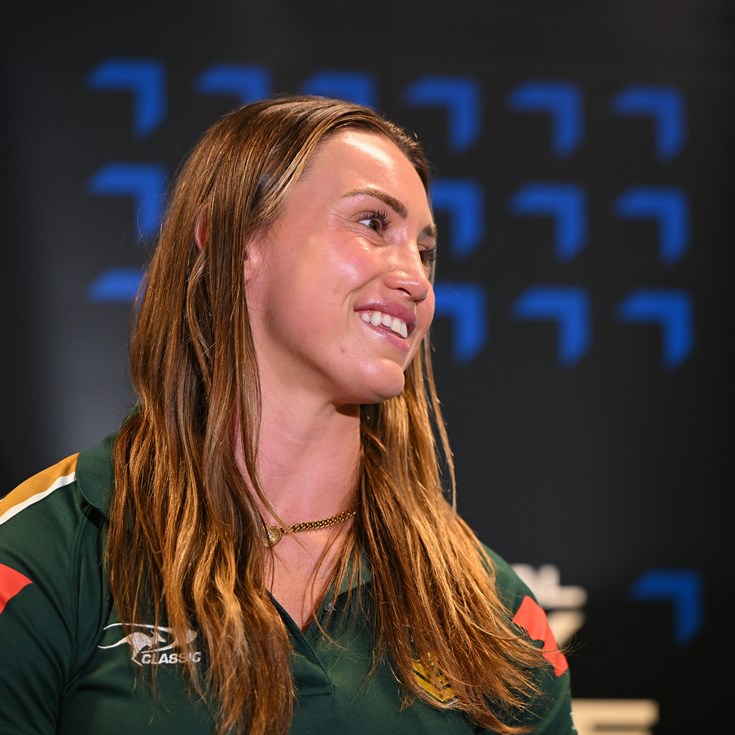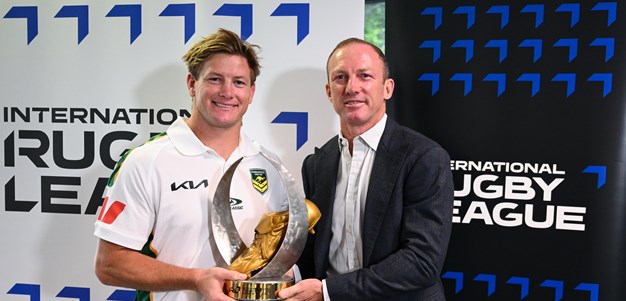First Nations Titans players met with a group of local NRL School to Work students last December and brainstormed ideas for the club's 2021 Indigenous Round jersey.
Using input from the likes of Jamal Fogarty, David Fifita and Tyrone Peachey, Mabel Park High School graduate Ash-Leigh Banks designed the strip that will be worn in Sunday's clash with the Sharks.
"I had the blue and the sandy tones," Banks, a proud Wiradjuri woman, said of the concepts featured in her painting.
"The blue representing more TI [Torres Strait] sides and the sandy tones representing the Aboriginal sides. The dots in the middle of the artwork show the players coming together as one and as a family.
"The footprints represent them walking onto the field every game carrying the culture with them and representing it."
Gold Coast also got staff polos made with Banks's design.
Indigenous Round to highlight inequality to move forward
While the club had collaborated with the community on previous Indigenous jersey designs, this time submissions were limited to the NRL School to Work students at Mabel Park High.
The School to Work program aims to help Indigenous students transition into tertiary education or meaningful employment. More than 2500 students have completed their HSC at a 96 percent success rate since the Government-funded initiative began in 2012.
"Mabel Park High School has been involved with the Titans for a few years," NRL School to Work officer Melissa Lightburn said.
"They've got a dance group and the students have performed at Indigenous Round as well as the Titans RAP launch, so as a special thank-you for them contributing to the club, the club wanted to extend this exclusive invitation to them to come up with a design.
"All [six of] the students who were in the workshop were invited to submit a design. It came down to two students from that group."
The club, including players and the Reconciliation Action Plan (RAP) Working Group, voted for the winner before a surprised Banks was told that her design had been chosen in February.
"It was the last thing I expected, honestly ... David Fifita and Jamal Fogarty gave us a Zoom call to tell them about our jersey design and then pretty much told me I won. It felt so surreal," she said.
Fogarty, the team's co-captain and halfback, said the Indigenous jersey was a means to represent culture and educate others.
"The NRL is doing a great thing with having their Indigenous Round every year where each team gets to design their jersey, whether that's [with help] from the local community or as a club and doing collaborations," Fogarty told NRL.com on Monday.
"We were lucky enough to get a young student from one of the high schools within our area. We were able to put together our ideas with her ideas or what we thought as players.
Because Origin isn’t motivated by victory, it’s powered by rivalry
"As Indigenous players, we've been taught to represent our area. She obviously had her ideas and she went away and put together the design that we're going to be wearing this week.
"I think the NRL is doing that the right way. It's appropriate to all tribes and the communities within the NRL and their areas. If we can keep this in the game and get the community more involved, I think we're definitely going in the right direction."
Banks said art has always been a big part of her family, but she "didn't really pick it up until about three years ago".
"It's become a big part of my life," said Banks, who after graduating is now studying a dual-diploma in beauty therapy while working.
"I just do it [art] for myself, but it's good having this opportunity to be able to do it for someone else and have it on a jersey."
She praised the School to Work program and Lightburn.
"I became a part of the program around three years ago," Banks said. "Ever since then, I've had such good support.
"Mel continues to check up, see if everything's going. It's a good program, I definitely recommend it."



